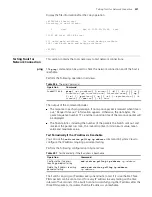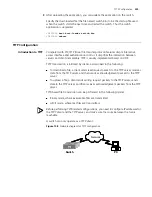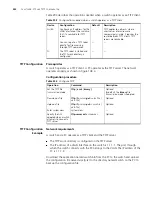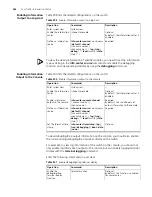
38
FTP
AND
TFTP C
ONFIGURATION
FTP Configuration
Introduction to FTP
FTP (File Transfer Protocol) is commonly used in IP-based networks to transmit files.
Before World Wide Web comes into being, files are transferred through command
lines, and the most popular application is FTP. At present, although E-mail and Web
are the usual methods for file transmission, FTP still has its strongholds.
As an application layer protocol, FTP is used for file transfer between remote server
and local host.
An Ethernet switch provides the following FTP services:
■
FTP Client
A switch can operate as an FTP client, through which you can access files on FTP
servers. In this case, you need to establish a connection between the switch and
your PC through a terminal emulation program or Telnet and then execute the
ftp
X.X.X.X
command on your PC. (X.X.X.X is the IP address of an FTP server.)
■
FTP Server
A switch can also operate as an FTP server to provide file transmission services for
FTP clients. You can log into a switch operating as an FTP server by running an FTP
client program on your PC to access files on the FTP server. In this case, the FTP
server must be configured with an IP address.
Figure 105
Network diagram for FTP configurations
Table 288 describes the operations needed when a switch operates as an FTP client.
Table 288
Configurations needed when a switch operates as an FTP client
Device
Configuration
Default
Description
Switch
Run the ftp command
directly to log into a
remote FTP server
—
To log into a remote FTP server, you need
to provide the user name and password.
FTP server
Have an FTP server
application run and the
corresponding operations
performed, such as
usernames, passwords,
and permissions to assess
files/directories.
—
—
Switch
PC
Network
Network
Switch
PC
Network
Network
Summary of Contents for 4200G 12-Port
Page 10: ...8 CONTENTS...
Page 14: ...4 ABOUT THIS GUIDE...
Page 46: ...32 CHAPTER 5 LOGGING IN THROUGH WEB BASED NETWORK MANAGEMENT SYSTEM...
Page 48: ...34 CHAPTER 6 LOGGING IN THROUGH NMS...
Page 60: ...46 CHAPTER 9 VLAN CONFIGURATION...
Page 64: ...50 CHAPTER 10 MANAGEMENT VLAN CONFIGURATION...
Page 80: ...66 CHAPTER 13 GVRP CONFIGURATION...
Page 98: ...84 CHAPTER 15 LINK AGGREGATION CONFIGURATION...
Page 112: ...98 CHAPTER 18 MAC ADDRESS TABLE MANAGEMENT...
Page 126: ...112 CHAPTER 19 LOGGING IN THROUGH TELNET...
Page 162: ...148 CHAPTER 20 MSTP CONFIGURATION...
Page 274: ...260 CHAPTER 29 IGMP SNOOPING CONFIGURATION...
Page 276: ...262 CHAPTER 30 ROUTING PORT JOIN TO MULTICAST GROUP CONFIGURATION...
Page 298: ...284 CHAPTER 33 SNMP CONFIGURATION...
Page 304: ...290 CHAPTER 34 RMON CONFIGURATION...
Page 338: ...324 CHAPTER 36 SSH TERMINAL SERVICES...
Page 356: ...342 CHAPTER 38 FTP AND TFTP CONFIGURATION...
Page 365: ...Information Center Configuration Example 351 S4200G terminal logging...
Page 366: ...352 CHAPTER 39 INFORMATION CENTER...
Page 378: ...364 CHAPTER 40 BOOTROM AND HOST SOFTWARE LOADING...
Page 384: ...370 CHAPTER 41 Basic System Configuration and Debugging...
Page 388: ...374 CHAPTER 43 NETWORK CONNECTIVITY TEST...
Page 406: ...392 CHAPTER 45 CONFIGURATION OF NEWLY ADDED CLUSTER FUNCTIONS...
















































